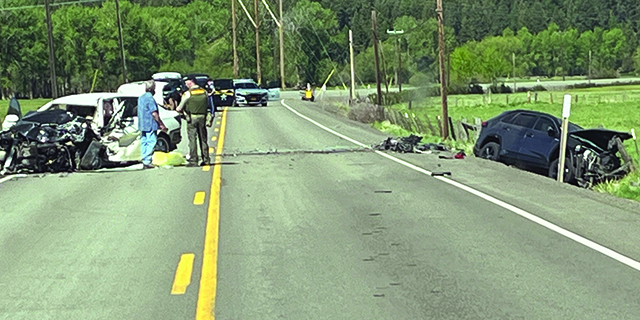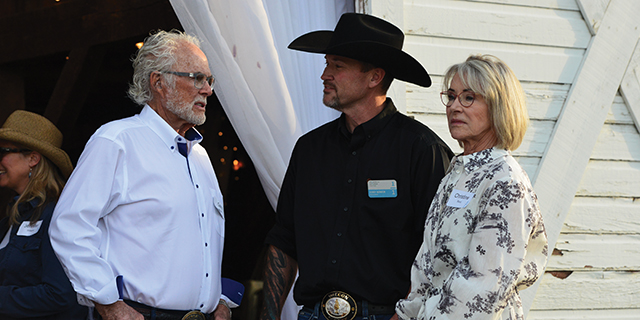Out and About: Hiking on history in the woods near Baker City
Published 7:00 pm Wednesday, May 22, 2024

- Jacoby
It’s hard to hike in Baker County without stepping on history.
From Native American artifacts, to much more recent evidence of the gold rush that led to the county’s creation in 1862, historical fragments are in many places common.
Compared with, say, the remnants of a mining cabin, its hand-notched logs still fitting snugly together after more than a century of blizzards and thunderstorms and summer heat, a pile of rocks might seem trivial.
But seen in context, even a stack of stones can tell a compelling story, can cause a wanderer to pause and to ponder the weight of history.
I had that experience recently while traipsing around very near where Baker County, in effect, was born.
The story starts on Oct. 23, 1861. That’s when Henry Griffin, one of a group of prospectors lured by tales of fabulous deposits, and perhaps even the (possibly apocryphal) Lost Blue Bucket Mine, found gold dust while panning in a gulch just southwest of the great valley of the Powder River.
Griffin’s discovery ignited the first gold rush in the eastern part of the fledgling state of Oregon, created by Congress just a couple years earlier, on Feb. 14, 1859.
(Even richer placer gold deposits were found less than a year later, on June 8, 1862, along Canyon Creek, near what would become Canyon City and John Day.)
The gulch that still bears Griffin’s name is a minor tributary of the Powder River, a desultory stream even during the spring snowmelt.
The bigger placer finds were several miles southwest, centered on the rather more substantial, spring-fed stream christened Blue Canyon.
The first settlement, called Auburn, started in 1862 on the stream’s banks and soon spread, like an infection carried in the blood, up the canyon and along its side channels such as Freezeout Gulch.
Auburn was the first seat of government for Baker County, which the Oregon Legislature carved out of Wasco County on Sept. 22, 1862.
The town, in common with the easily collected placer gold, was worked out relatively quickly.
The upstart town in the Powder River Valley, Baker City, replaced Auburn as county seat in 1868, six years before Baker City was officially incorporated.
Nothing today remains of Auburn. Most of the area where the town’s buildings stood are private property north of Old Auburn Road, which becomes Forest Road 7220 when it enters the Wallowa-Whitman National Forest.
But much of Blue Canyon, and a side stream that flows into it from the north, are on national forest land.
It’s among my favorite spring hikes. The elevation is modest — around 4,500 feet — so the snow melts much earlier than in the high Elkhorns or Wallowas.
Neither Blue Canyon nor its tributary is a noteworthy waterway. In most places even a clumsy hiker — me, for instance — can hop across the channel without great exertion (or getting awfully wet).
The draw, at least for me, is the history.
Specifically, the sinuous ridges of what I’m pretty certain were hand-piled stones, tailings from mining, that extend along significant sections of both streams.
The northern tributary is the more interesting, not least because there’s much less underbrush to obscure the walls of tailings (and, of course, to claw for a blundering hiker’s eyes).
I have explored these formations many times, and on each visit I am struck anew by the palpable sense of all that happened here long before anyone alive today had taken a first breath.
I pluck a single stone and ponder how it came to be here.
Who placed it, along with the thousands of others?
How long has the rock been in this spot, locked against its companions until I came along nearly a quarter of the way through the 21st century?
Were mine the first human hands to touch its cold surface since the turn of the 19th century? Since the Great War was bloodying France and Belgium?
What was the day like when this rock was last touched? Was the miner just starting another long day of labor, or was this the last rock he hefted as the sun was slinking below the sedimentary shoulder of the Elkhorns to the northwest?
Was it a frigid day in January, the miners clad in wool, or was it the awful heat of August (and no air-conditioned rig to climb into for the drive home)?
These are questions beyond answering.
Yet still I find the contemplation of such mysteries endlessly fascinating.
I appreciate that a walk in the woods can be something more, that each step is akin to turning a page in a history book.





